Release 1.0.2.1 for Windows NT/2000
Part Number A88726-01
Library |
Contents |
Index |
| Oracle9i Application Server Installation Guide Release 1.0.2.1 for Windows NT/2000 Part Number A88726-01 |
|
This chapter guides you through the installation steps for the Enterprise Edition of Oracle9i Application Server. The following topics provide detailed installation steps, and basic postinstallation tasks:
The following instructions prepare your machine for the installation of Oracle9i Application Server.
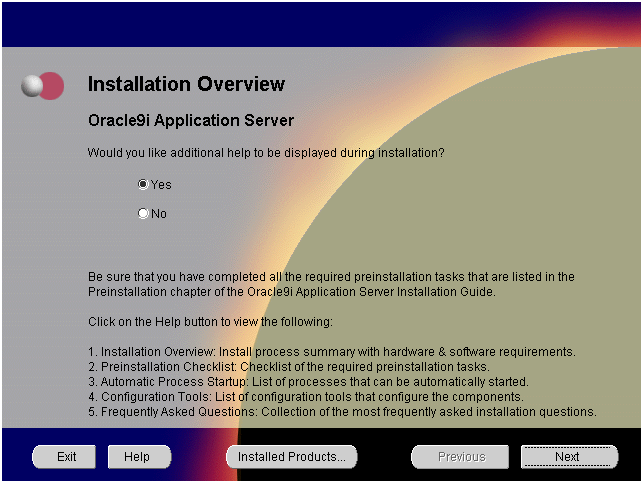
The Installation Overview screen enables you to launch and view additional installation help and information during installation. Both choices enable you to click Help to view information for each screen.
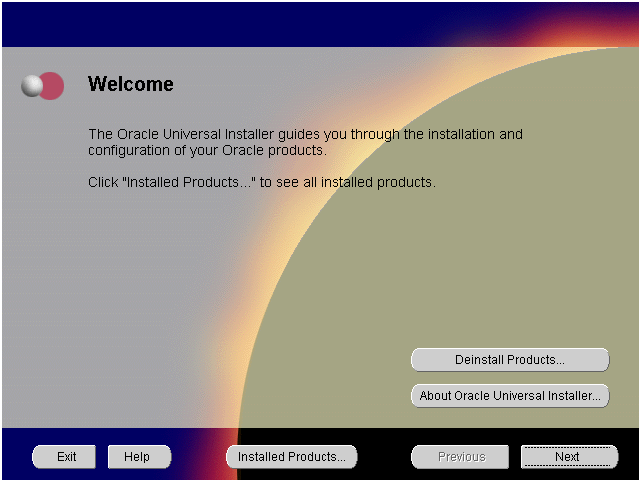
The Welcome screen provides information about the Oracle Universal Installer.
The following function buttons appear on the installation screens.

The Installation Types screen allows you to select the Oracle9i Application Server installation option that you are licensed to use.
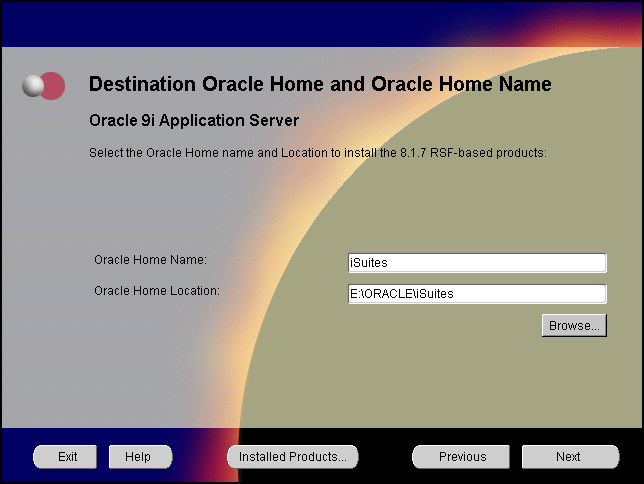
The Destination Oracle Home and Oracle Home Name screen allows you to enter the name and location of your Oracle home for the 8.1.7 RSF based products. You can accept or change the defaults.
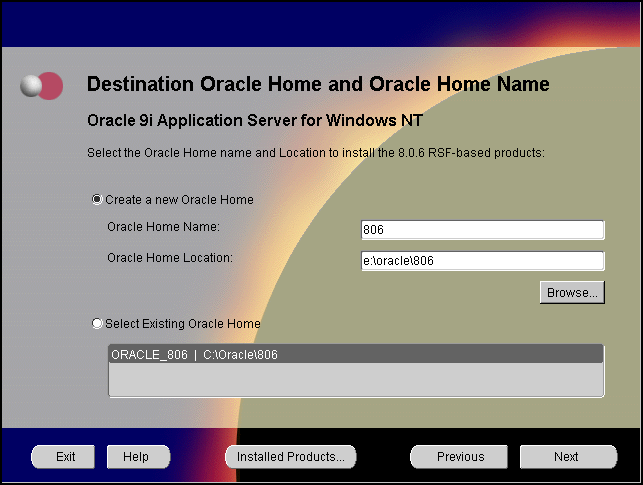
The Destination Oracle Home and Oracle Home Name screen allows you to either enter the name and location for the 8.0.6 RSF based products, or select an existing Oracle home if you are upgrading from a previous version of Oracle9i Application Server. You can accept or change the defaults.
- Oracle Home Name: This is the name of the Oracle home, which is the root directory in which Oracle9i Application Server is installed.
- Oracle Home Location: This is the full path of the Oracle home directory.
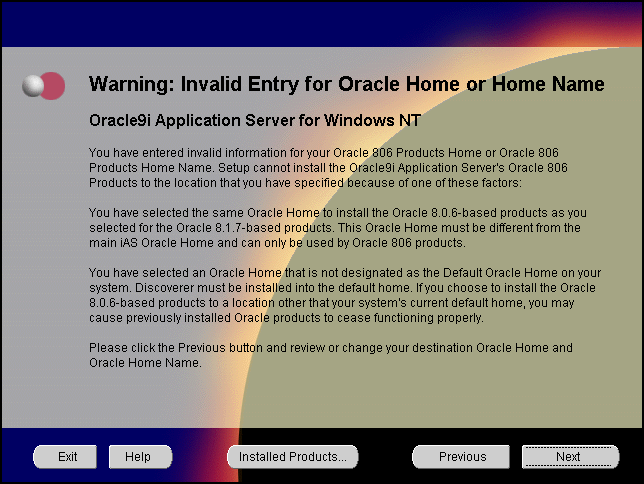
The Invalid Oracle Home Entry Warning screen alerts you of an invalid Oracle home entry made for the 8.0.6 RSF based products. It requires you to click the Previous button to go back to the Destination Oracle Home Name and Oracle Home Location screen and enter a valid name. After making the appropriate corrections, click Next.
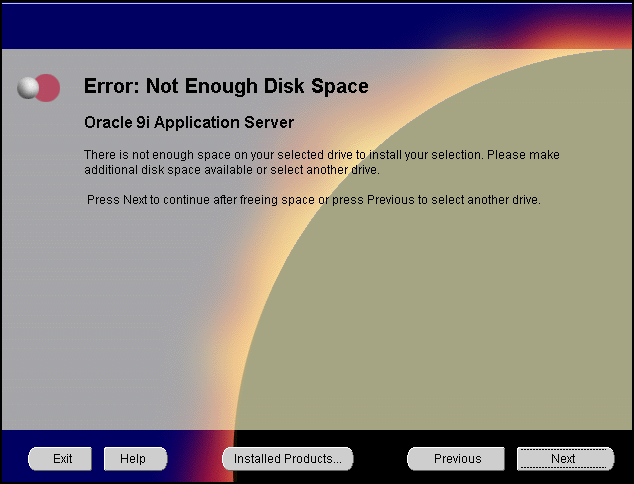
Insufficient Disk Space screen appears only if you do not have enough disk space on your selected drive to install Oracle9i Application Server. You can:
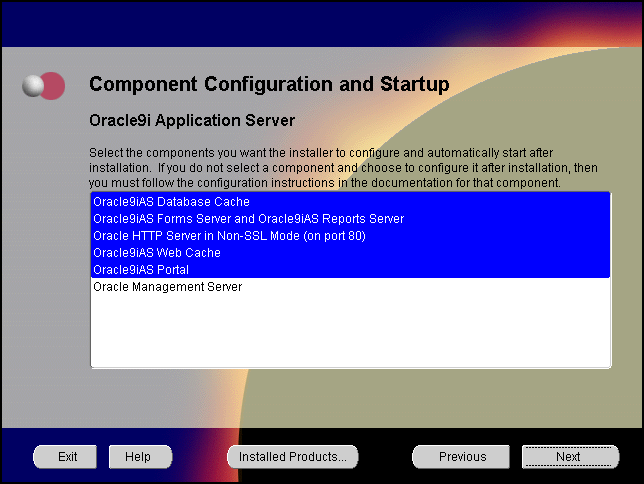
The Component Configuration and Startup screen allows you to select the components that you want the installer to configure and start after installation. This screen offers two configuration options:
You can select or de-select multiple components by holding down the Control key while clicking on the component name.
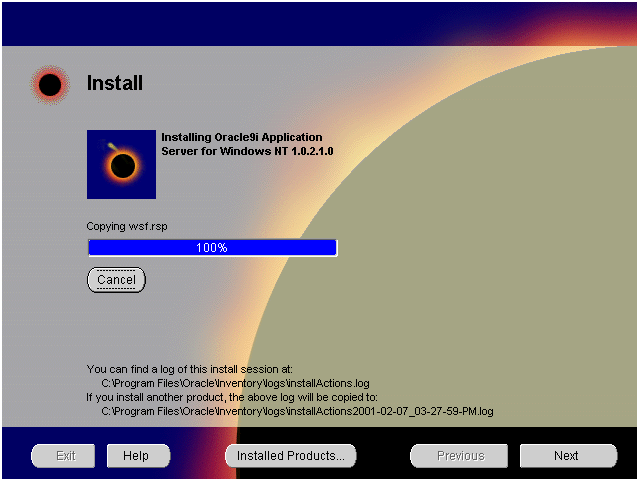
The Install screen appears while Oracle Universal Installer incorporates all the user input for Oracle9i Application Server. It also displays the full path of the installation log.
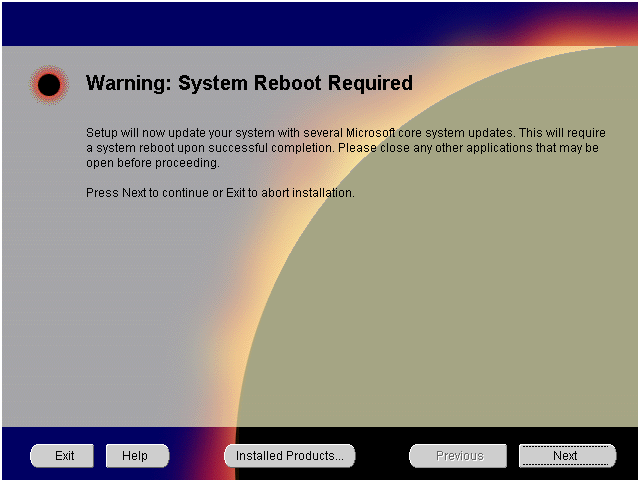
The System Reboot screen informs you that after the installer copies the necessary files required to install Oracle9i Application Server, your machine will reboot to allow the configuration changes to take effect. When the machine starts up again, Oracle Universal Installer appears and begins the installation process of the Oracle9i Application Server.

The Install screen appears while Oracle Universal Installer installs required configuration files for Oracle9i Application Server. It also displays the full path of the installation log.
Your machine will reboot once the configuration files are copied. Do not attempt to restart the installer after reboot. It will launch automatically.
Once your machine starts up after rebooting, the Oracle Universal Installer appears and proceeds to install Oracle9i Application Server The reboot process will not occur if you are installing on Windows 2000.
The following screen appears as Oracle Universal Installer relaunches.The installer may take up to several minutes to start, and might pause if some screensavers are activated.

This screen appears only if Oracle Universal Installer has detected insufficient disk space in the Oracle home directory.
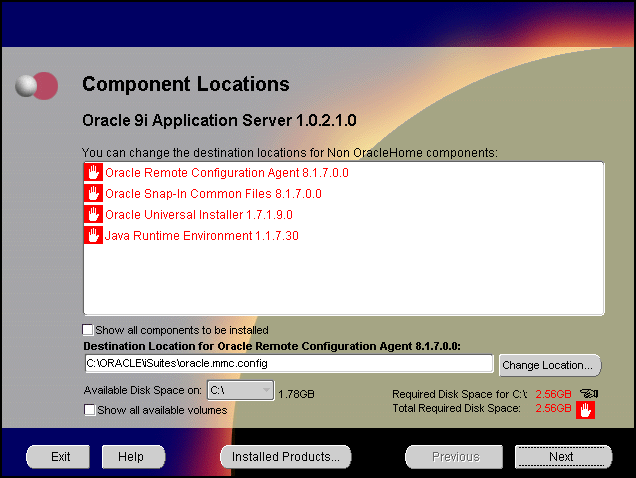
The Component Locations screen allows you to select alternative locations for some components.
Click individual components to view and change destination location path. The installer enables you to change the destination location of the components displayed on the screen.
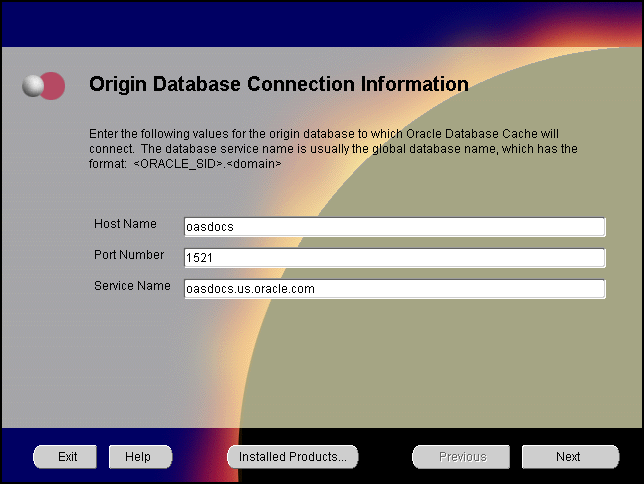
The Origin Database Connection Information screen enables you to identify the origin database for the middle-tier cache.
tnsnames.ora file on the local cache node.
For example, if oasdocs is the database name and us.oracle.com is the network domain in which the database is located, then the service name is oasdocs.us.oracle.com.
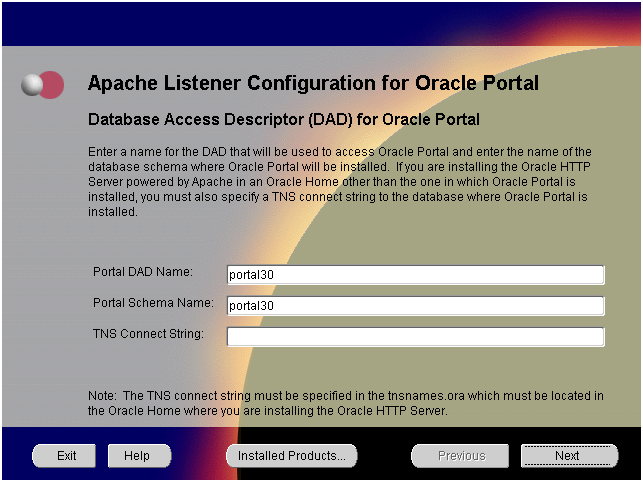
The Apache Listener Configuration for Oracle Portal DAD screen allows you to enter the name of the Database Access Descriptor (DAD) that will be used to access Oracle Portal, and the name of the database schema where Oracle Portal will be installed. It also enables you to enter the TNS connect string if Oracle Portal and Oracle HTTP Server are installed in different Oracle homes. The information you enter here is used to create the PL/SQL Gateway settings which you can access upon installation from the following location: http://machine_name:port/pls/admin_/gateway.htm
portal30.
portal30.
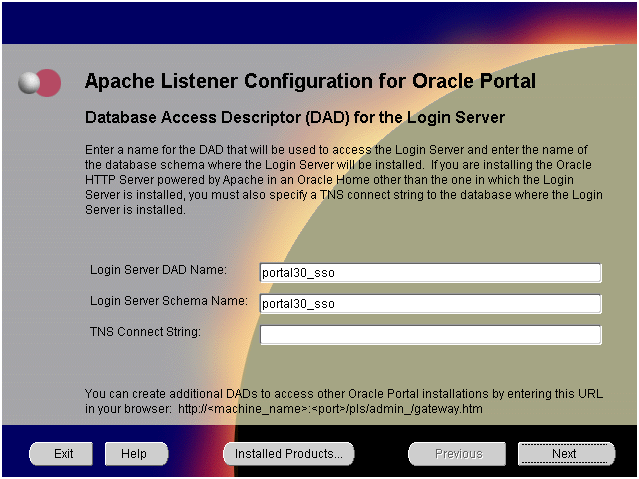
The Apache Listener Configuration for Oracle Portal screen allows you to enter the Login Server DAD and Schema Name, with a _sso extension for easy recognition. The Login Server provides an enterprise-wide Single Sign-On (SSO) mechanism that enables an Oracle Portal user to log in securely to Oracle Portal and any partner and external applications using a single user name and password. It also enables you to enter the TNS Connect String if Oracle Portal and Oracle HTTP Server are installed in different Oracle homes.
portal30_sso.
portal30_sso.
For more information on these fields, refer to the previous screen.
SYSDBA name and password and click Next. This screen will appear only if you have selected Oracle9iAS Database Cache in the Component Configuration and Startup screen.
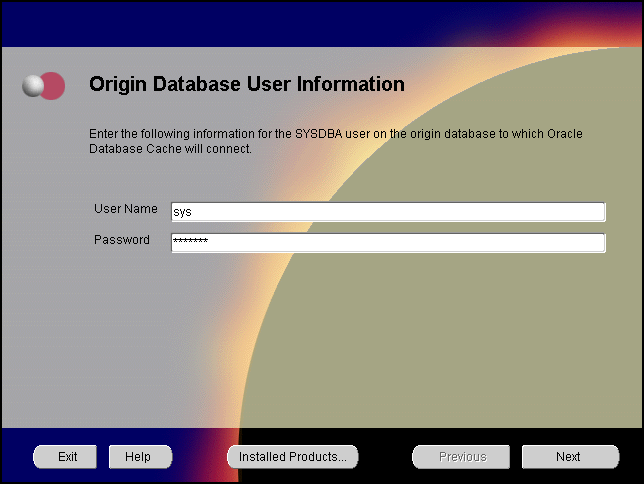
The Origin Database User Information screen allows you to enter the SYSDBA information created for the origin database.

The Wireless Edition Repository Information screen allows you to enter the hostname, Net8 Listener port number, and SID of the database where you will install the Oracle9iAS Wireless repository.
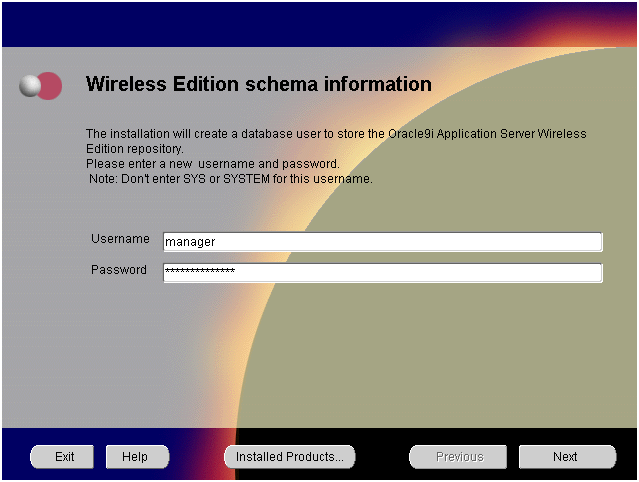
The Wireless Edition Schema Information screen allows you to create a database user to store the Oracle9iAS Wireless repository.
SYSTEM password of the database, and click Next. If you are upgrading from Oracle9i Application Server, Release 1.0.2, then a "Wireless Edition Administrator Password Information" screen appears. Enter and confirm the "Administrator" password, and click Next.
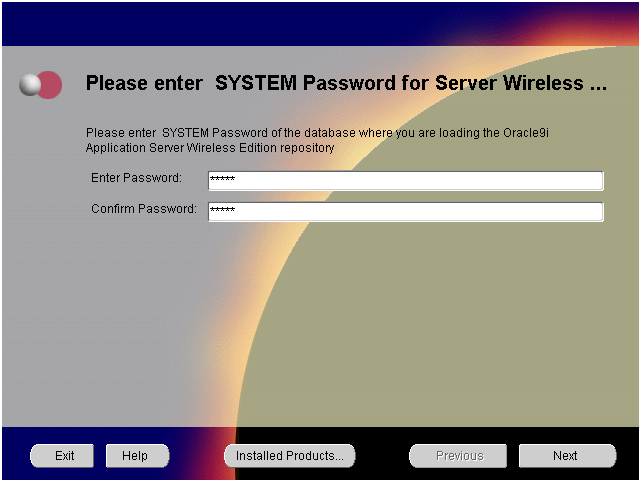
The System Password screen allows you to enter and confirm the SYSTEM password of the database where you are loading the Oracle9iAS Wireless repository.
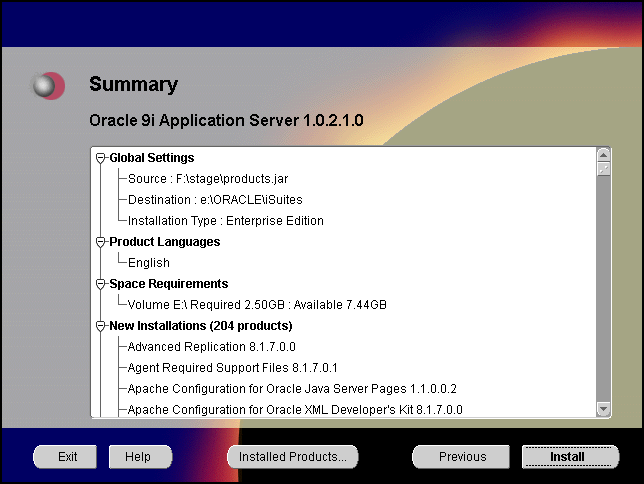
The Summary screen allows you to review all the settings before the actual installation process. These settings include source, destination, installation type, product language, space requirements, and a list of components.
When you click Install, the installation process begins.
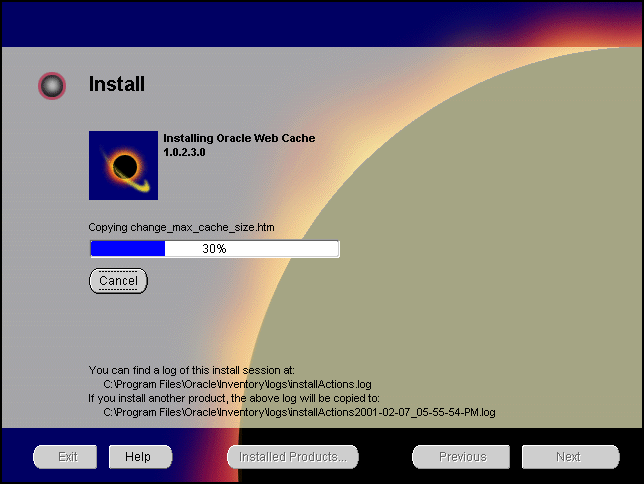
The Install screen appears while the product is installing. Installation operations include executing actions such as file copy and linking, and executing decision points and calculations. It also displays the full path of the installation log.
Changing Disks: During the installation process, the Disk Location dialog appears and prompts you to change disks. Insert the requested disk into your disk drive, or specify an alternative location, and click OK.
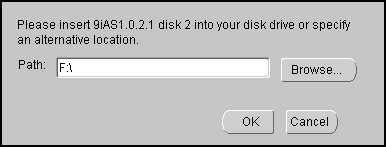
The following screen indicates that Oracle Installer is installing Oracle9iAS Forms Services, Oracle9iAS Reports Services, and Oracle9iAS Discoverer. No user input is required.
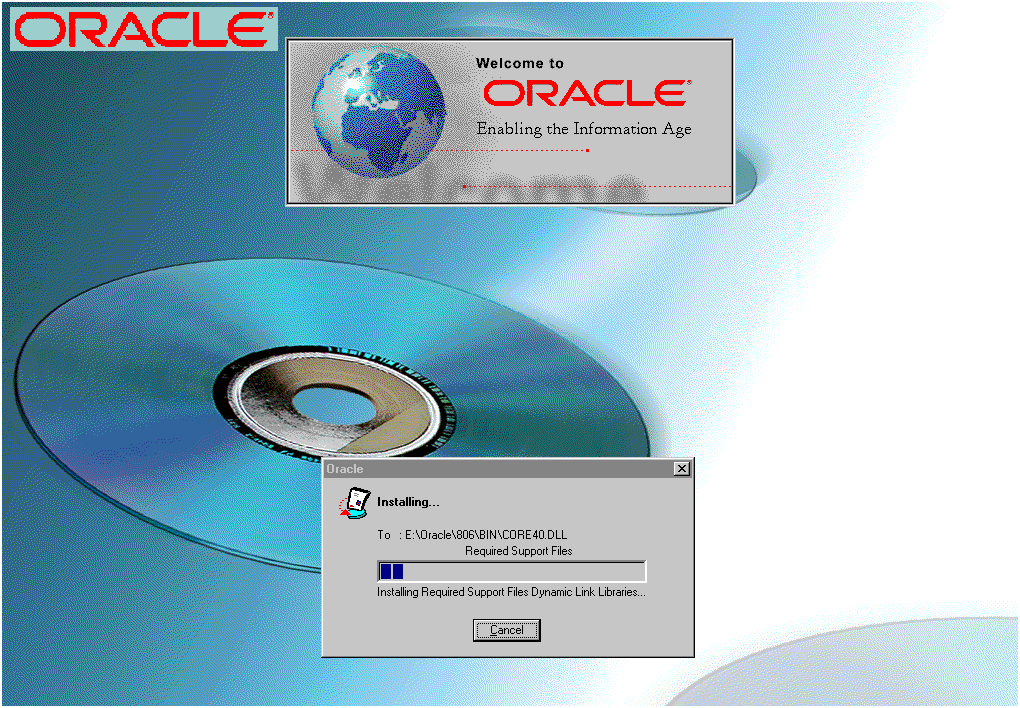
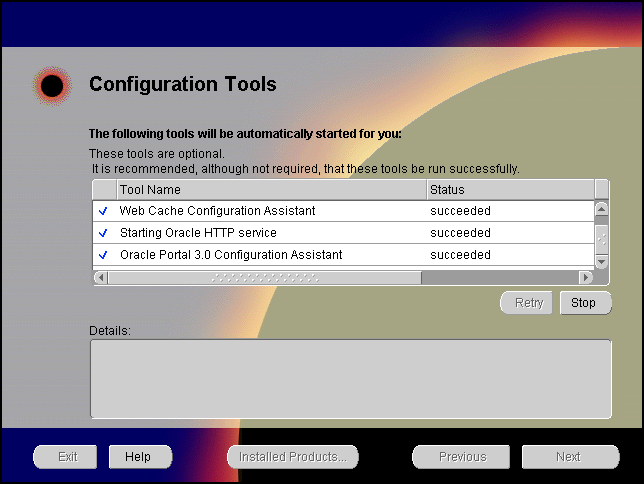
The Configuration Tools screen lists the configuration tools for all installed components.
Scroll down the list to review the configuration status of each tool. The status changes as each component is configured.
The installer performs the following functions in this screen:
Configuration Tools
Depending on the components you select in the Configuration and Startup screen, the following configuration tools launch:
Oracle9iAS Database Cache Configuration Assistant - This configuration assistant enables you to configure your middle-tier caches. Oracle9iAS Database Cache Configuration Assistant will not appear if you are migrating from Oracle9i Application Server 1.0.2.0 to 1.0.2.1.
|
See Also:
"Oracle9iAS Database Cache Configuration Assistant" for instructions on running Oracle9iAS Database Cache Configuration Assistant. |
Oracle9iAS Web Cache Configuration Assistant - This launches the service to start Oracle9iAS Web Cache. Oracle9iAS Web Cache service starts up automatically by default. If you choose not to use Oracle9iAS Web Cache, you will need to stop the service manually.
Starting Oracle HTTP service- This starts the Oracle HTTP Server.
Oracle HTTP Server starts up in a DOS window. In that window, you can test the Oracle HTTP Server installation.
To administer the Oracle HTTP service from the Control Panel, reboot your machine after Oracle9i Application Server installation completes. Then, Oracle HTTP service will start automatically and you will no longer need to start it in a DOS window.
Oracle9iAS Portal Configuration Assistant - This configuration assistant loads necessary database objects for Oracle9iAS Portal to run.
|
See Also:
"Oracle9iAS Portal Configuration Assistant" for instructions on running Oracle9iAS Portal Configuration Assistant. |

The End of Installation screen appears at the end of the installation process. It notifies you whether the installation was successful or unsuccessful.
You have successfully installed the Enterprise Edition installation option of Oracle9i Application Server. Proceed to "Postinstallation" to complete the installation process.
The following instructions guide you through the basic postinstallation tasks for Oracle9i Application Server. Before performing these tasks, install, if needed, Oracle9iAS Wireless client from the Oracle9i Application Server Administrative and Development Client CD included in the Oracle9i Application Server CD pack.
The postinstallation contains the following sections:
This section contains postinstallation tasks for the following topics:
You must run the Oracle Internet File System Configuration Assistant to configure Oracle Internet File System.
|
See Also:
"Oracle Internet File System Configuration Assistant" for instructions on running Oracle Internet File System Configuration Assistant. |
You must run the Oracle Enterprise Manager Configuration Assistant to configure Oracle Management Server.
|
See Also:
"Oracle Management Server Configuration Assistant" for instructions on running Oracle Enterprise Manager Configuration Assistant. |
Be sure to perform the following postinstallation steps for Oracle9iAS Database Cache:
When you install Oracle9iAS Database Cache, the installation procedure installs files that are specific to Oracle9iAS Database Cache and files that are updates to Oracle8i Server or Client release 8.1.6.1. These files contain the Oracle9iAS Database Cache functionality, as well as bug fixes to files usually installed with the Oracle8i Server or Client.
To use Oracle9iAS Database Cache, you must make sure that your applications are using the files and libraries installed for Oracle9iAS Database Cache. You can do this in the following ways:
"Using a Previous Oracle8i Release 8.1.6 Oracle Home" for a description of the steps you must take.
See Also:
OCI libraries that are installed by Oracle9iAS Database Cache.
"Relinking Applications That Use Releases Previous to Release 8.1.6" for more information.
See Also:
To run your application from the Oracle home in which you installed Oracle9iAS Database Cache, you must take the following steps:
ORA_OCI_CACHE to "1" so that all applications started from the process will use the cache. (Alternatively, you can use parameters within OCI applications to control which applications or statements use the cache.
TNS_ADMIN, make sure that it is set to the ORACLE_HOME\network\Admin directory in the Oracle home for Oracle9iAS Database Cache.
PATH so that the Oracle9iAS Database Cache library directory (ORACLE_HOME\lib) precedes other Oracle library directories.
CLASSPATH environment variable, set it to the Oracle home in which you installed Oracle9iAS Database Cache.
TNS_ADMIN, make sure that it is set to the ORACLE_HOME\network\Admin directory in the Oracle home for Oracle9iAS Database Cache. The registry parameter is located in the following location:
HKEY_LOCAL_MACHINE\SOFTWARE\ORACLE\HOME id
Oracle for Windows NT -> Oracle Home Selector. Then, select the Oracle home in which you installed Oracle9iAS Database Cache.
tnsnames.ora file, you must copy that entry to the tnsnames.ora file used by Oracle9iAS Database Cache.
The tnsnames.ora file is located in the ORACLE_HOME\network\Admin directory. Copy the entry from the file in the previously existing Oracle home to the tnsnames.ora file in the Oracle home in which you installed Oracle9iAS Database Cache.
Note that the Oracle9iAS Database Cache installation creates an entry for the origin database in the tnsnames.ora file on the local cache node. It assigns the alias ora_icache_origin. Do not modify or delete the ora_icache_origin entry. To assign a different alias for another purpose, edit the tnsnames.ora file and add another entry. The Oracle9iAS Database Cache installation also creates an entry, ora_icache, for the cache. Do not modify or delete this entry.
If you previously ran your application from the Oracle home for Oracle8i Server or Client release 8.1.6 or 8.1.6.1 and you continue to need to run your application from that Oracle home, you must take the following steps:
ORACLE_HOME\bin\oraclient8.dllORACLE_HOME\bin\orageneric8.dll (not required for 8.1.6.1)
ORACLE_HOME\bin\orawtc8.dllORACLE_HOME\bin\orawtc8.lib
Oracle for Windows NT -> Oracle Home Selector. Then, select the Oracle home for the Oracle8i server or client that your application uses.
ORA_OCI_CACHE to "1" so that all applications started from the process will use the cache. (Alternatively, you can use parameters within OCI applications to control which applications or statements use the cache.)
TNS_ADMIN, make sure it points to the Oracle home that your application uses.
tnsnames.ora file from the Oracle home in which you installed Oracle9iAS Database Cache to the tnsnames.ora file in the Oracle home for the Oracle8i server or client that your application uses.
If your application was compiled and linked using a release prior to Oracle8i Server or Client release 8.1.6, you must relink your application using the OCI libraries that are installed by Oracle9iAS Database Cache.
Then, you must take the steps described in "Using the Oracle9iAS Database Cache Home" .
The Oracle9iAS Database Cache installation creates a cache using the same database character set as the origin database. However, it does not set other National Language Support (NLS) features, such as date format or currency symbols.
If the initialization file (initSID.ora) of your origin database specifies NLS parameters, you must copy those parameters to the initialization file (initicache.ora) of the cache. (NLS parameters begin with "NLS_".)
For example, if the initialization file of your origin database contains the following parameters, copy them to initicache.ora:
NLS_LANGUAGE = JAPANESE
NLS_CALENDAR = "Japanese Imperial"
NLS_DATE_FORMAT = "E YY-MM-DD"
initicache.ora is located in the ORACLE_HOME\Admin\icache\pfile directory.
Oracle Corporation recommends that you configure Oracle9iAS Database Cache files, directories, and registry settings to allow only authorized database administrators to have full control. The following sections describe how to perform these tasks.
See your Windows NT documentation for more information about modifying NTFS file system and Windows NT registry settings.
Oracle9iAS Database Cache uses files to store data and configuration information. To do this, the Oracle9iAS Database Cache process runs under a security account. This security account (the account under which you installed Oracle9iAS Database Cache) includes the ability to create and access these files. The security account is assigned to the service that Oracle9iAS Database Cache uses (in the Control Panel). This account requires full file system permissions to create, read, write, delete, and execute files.
To ensure that only authorized users have full file system permissions:
ORACLE_HOME\bin), Oracle9iAS Database Cache directories, and files for the cache (in ORACLE_HOME\dbs).
Oracle Corporation recommends that you remove write permissions in the NT registry from users who are not DBAs or system administrators.
To remove write permissions:
HKEY_LOCAL_MACHINE\SOFTWARE\ORACLE.
This section guides you through configuring SSL for Oracle9iAS Database Cache, Oracle Servlets Engine for Java, Distributed CORBA Applications, and Enterprise JavaBeans.
These steps guide you through the SSL configuration for the following:
To configure Oracle9iAS Database Cache to use SSL, remove the comment characters (#) from the following entry in the listener.ora file:
For secure connections over SSL, uncomment the following lines:
# (DESCRIPTION = # Secure TCP connections # (ADDRESS = # (PROTOCOL = TCPS) (HOST = host_name) (PORT = 2484) # ) # )
The listener will listen for all SSL requests.
To configure Oracle Servlets Engine for Java to use SSL, (in addition to removing the comment characters from the appropriate line in the initialization file) you must remove the comment characters (#) from the following entry in the tnsnames.ora file:
# Support for mod_ose over TCP with SSL connections. # inst1_https = # (DESCRIPTION = # (ADDRESS = # (PROTOCOL=TCPS) # (HOST=host_name) # (PORT=2484) # ) # (CONNECT_DATA= # (SERVICE_NAME=MODOSE) # (SERVER=shared) # (PRESENTATION=http://admin) # ) # )
To configure distributed CORBA application and Enterprise JavaBeans to use SSL, (in addition to removing the comment characters from the appropriate line in the initialization file) you must remove the comment characters (#) from the following entry in the listener.ora file:
For secure IIOP connections over SSL, uncomment the following lines:
# (DESCRIPTION = # Secure IIOP Connections # (PROTOCOL_STACK = # (PRESENTATION=GIOP) # (SESSION=RAW) # ) # (ADDRESS=(PROTOCOL=TCPS)(HOST=% s_host_name%)(PORT=2482)) # )
These steps guide you through configuring Oracle9iAS Database Cache as a Multi-threaded server for Oracle Servlets Engine for Java, Distributed CORBA Applications, and Enterprise JavaBeans:
To configure Oracle9iAS Database Cache as a multi-threaded server (MTS) for Oracle Servlets Engine for Java, you must make one or both of the following changes to your initialization file (instSID.ora):
# mts_dispatcher = "(PROTOCOL=TCP)(SERV=MODOSE)"
# mts_dispatcher = "(PROTOCOL=TCPS)(SERV=MODOSE)"
For information on enabling SSL for Oracle9iAS Portal, refer to Oracle Portal 3.0.8 Configuration Guide.
Distributed CORBA Applications and Enterprise JavaBeans
To configure Oracle9iAS Database Cache as a multi-threaded server (MTS) for distributed CORBA applications and Enterprise JavaBeans, you must make the following changes in your initialization file (instSID.ora):
# mts_dispatcher = "(PROTOCOL=TCP)(PRE=oracle.aurora.server.SGiopServer)"
# mts_dispatcher = "(PROTOCOL=TCPS)(PREoracle.aurora.server.SGiopServer)"
You can manually start and stop a component by doing the following:
Table 5-1 lists the service names for the Oracle9i Application Server components.
Table 5-2 lists Web sites for Oracle9i Application Server components.
Table 5-3 lists the default port numbers on which requests are received for each component.
For further information on postinstallation and configuration tasks, refer to component-specific documentation. For information on viewing and installing the documentation, refer to Appendix E, "Installing Documentation Library".
|
|
 Copyright © 2001 Oracle Corporation. All Rights Reserved. |
|